Our content features commercial links to our products, committed to transparent, unbiased, and informed editorial recommendations. Learn More
How to Sharpen a Katana like a Japanese Swordsmith
NO AI USED This Article has been written and edited by our team with no help of the AI
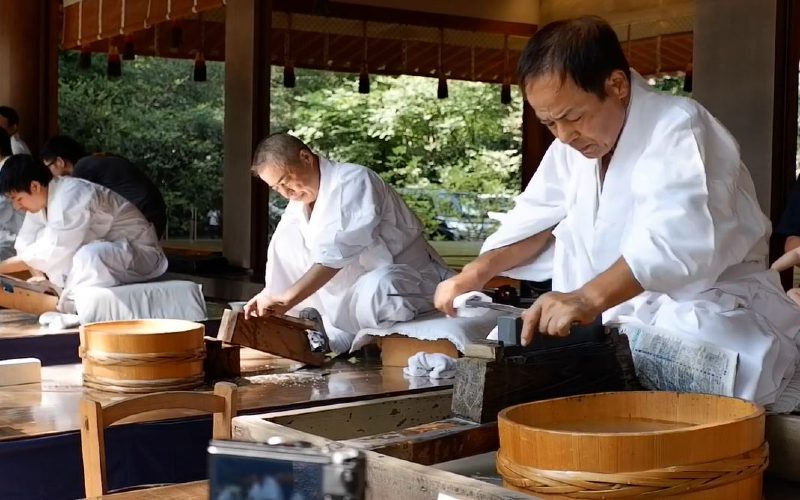
The Katana is a Japanese samurai sword and the most popular blade in the world. It has one edged curved blade made of tamahagane steel which is very sharp and deadly. In order for a Katana to be effective, it needs regular sharpening.
This article will explain how to best sharpen your Katana sword. You will learn what you need before sharpening, how to sharpen, and additional ways to sharpen your sword. Then we’ll discuss why sharpening the Katana is so important and how often you should do it.
What you Need before Sharpening a Katana
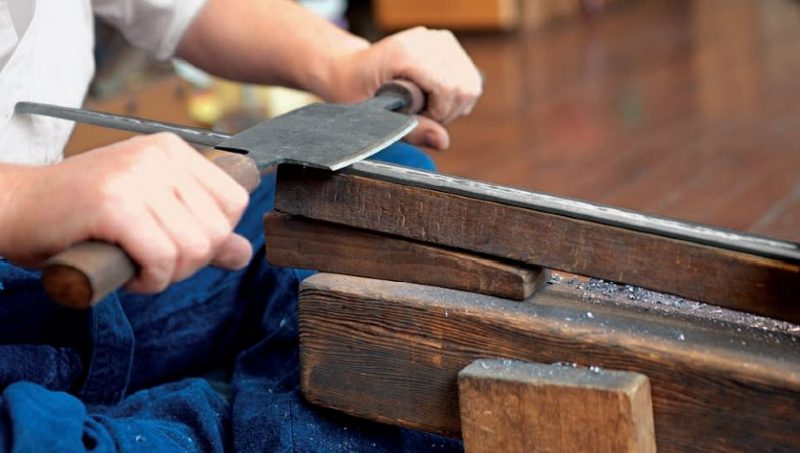
There are a number of things you will need before sharpening a Katana. Owning a Katana can be costly as you will periodically need to spend a couple of bucks on some of the materials.
Whetstone
Sharpening stones, also called whetstones, are used to sharpen and polish the edges of the Katana. These stones come in many different sizes, shapes, and types, but we recommend the flat stone for the Katana.
A grit of 1000 to 1500 for the whetstone should be enough to sharpen Katana swords. You can also get different grits of synthetic whetstones, which are Japanese stones used to sharpen knives. However, these stones can cost much more than regular whetstones.
Oil
Oil might be needed when sharpening your Katana sword, although water will sometimes do the job just fine too. A very good oil that we recommend is the 3-in-1. You can get this type of oil in most of your stores that sell guns or steel equipment tools.
Even though it might be tempting to use vegetable oil, which is readily available, we strongly advise against it.
Grit Sandpaper
The 3M emery cloth sandpaper is ideal for sharpening your Katana sword. It is made for sanding metals that need to last, like getting rid of rust and corrosion. In addition, this type of cloth won’t shred or tear the high-quality stainless steel.
Work Desk or Board for Comfortable Sharpening
The sword can be placed on any surface. Most of the time, the blade’s edge will rest on one side of the desk or board you’re working on so that when you scrape or sharpen the blade, you won’t hurt it. Sometimes the plainest wood board will work just fine.
Clean Water – Spray Bottle
When Japanese water stones are used, they will get worn down. This is normal and helps with keeping the cutting surface sharp.
That’s why we recommend keeping a container with water next to you. This is a lifesaver because you won’t constantly run around getting water. Also, we recommend filling a spray bottle with water. This way, you can spray water when needed.
Cloth for Wiping and Grip
Any type of cloth will do. The cloth is used mainly to clean the Katana’s blade and make the surface easier to work with. The process of sharpening a Katana starts and ends with this tool.
Also, ensure that you have an extra dry cloth so you can hold the Katana when sharpening. It will reduce the chance of you hurting yourself.
Paper or Foam for the Cutting Test
Any type of paper or foam will do. Slice the Katana’s blade through the paper or let it simply fall through it. If it can easily cut through, your Katana will have a sharp edge and be well-polished.
How to Sharpen a Katana
These are the essentials for sharpening a Katana.
Safe & Quiet Environment
Find a quiet and safe environment where you won’t be interrupted. You are working with a very sharp sword, and a slight mistake or something distracting your focus can lead to losing a finger.
Wipe
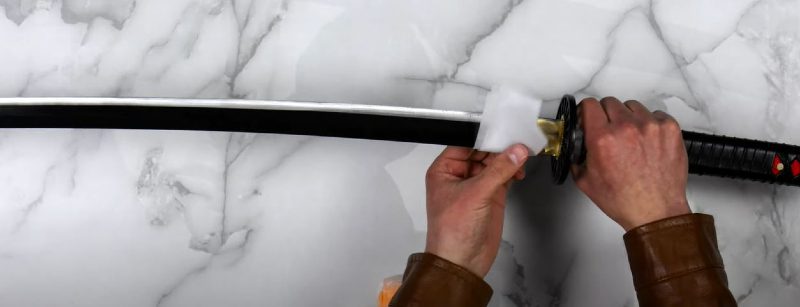
Start by wiping the sword carefully with a thick cloth to remove any oil, dust, or residue that may have built up since the last time you sharpened your blade. Move the cloth very carefully along the blade without pressing down on it. This will keep you from cutting yourself accidentally.
Water the Whetstone
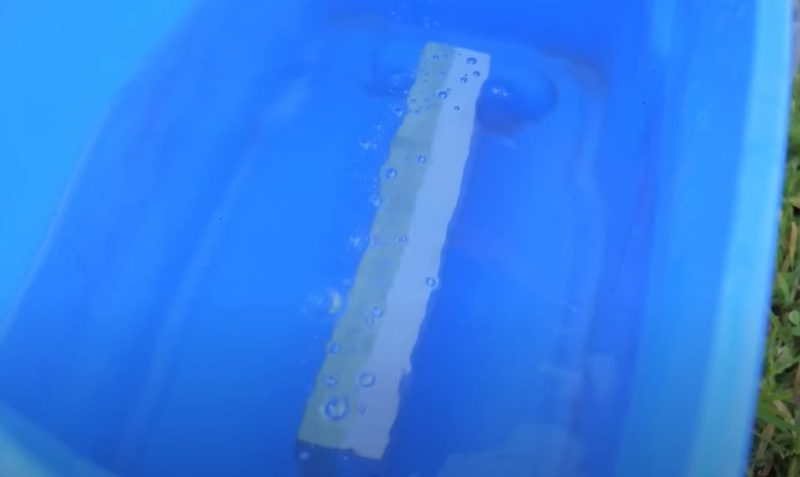
Place the whetstone underwater for some time to soak it. Usually, you can leave the whetstone in water for 15-20 minutes. This will make the surface much better when sharpening the delicate Katana. Now you may begin the sharpening process.
Sharpening
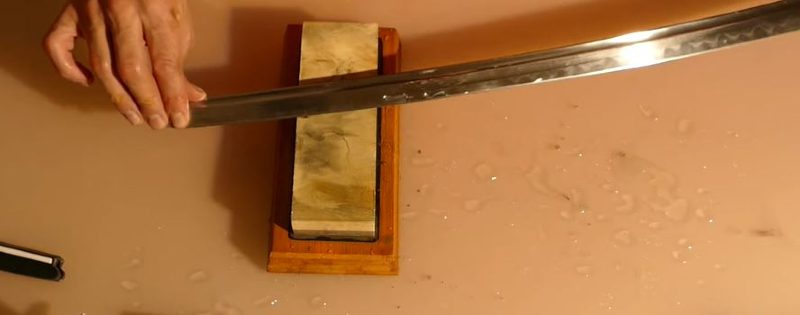
The Katana is sharpened at a 15-degree angle. You can hold this angle with your thumb. As you keep working on it, your muscle memory will begin getting used to it.
Lay the Katana on its side, as close to the tang as you can get. Raise the spine just a little to find the right angle for sharpening. For more stability, put one hand on the tang (which is wrapped in a cloth) and one hand on the blade’s spine.
As you push the blade into the stone, drag it diagonally so you can use as much of the cutting edge as possible in one stroke. Then, put the blade back and do it again. You should be applying 4-6 lbs of pressure when sharpening your Katana against the whetstone.
Make 3-5 passes on each side. Start with either the left or the right side. Then do an equal amount of passes with the other side.
Watering and Oiling
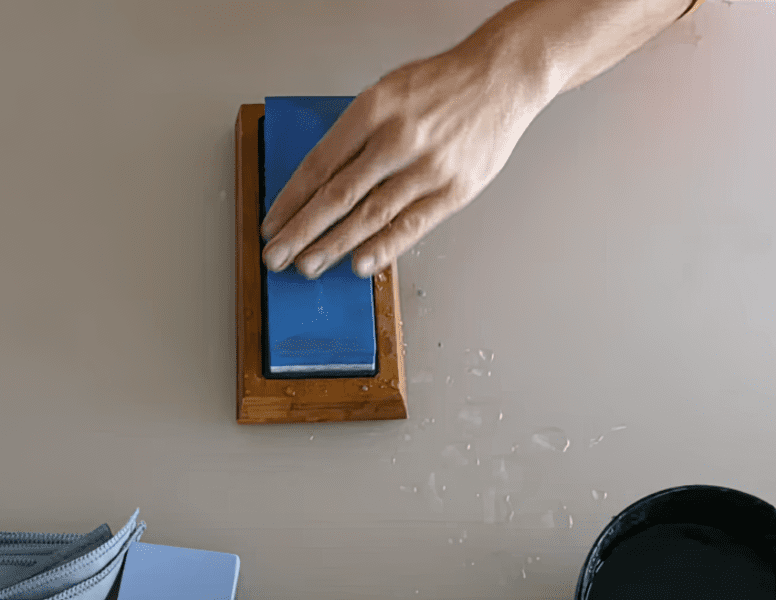
Don’t forget to keep watering and oiling your whetstone while sharpening your Katana. Apply the water or the oil on the surface of the whetstone. Usually, it is recommended to apply water or oil after every 3rd pass.
Blend the Edge
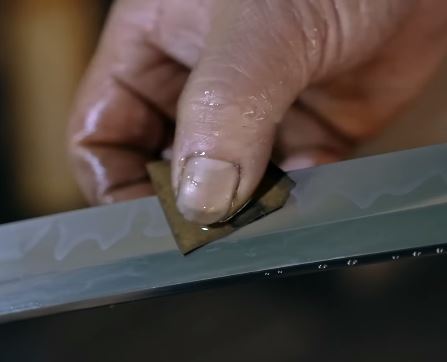
This is optional, and only a few people will do it. After you’ve finished sharpening your blade, you may take your sandpaper and start blending the edge to get rid of any imperfections on the blade’s surface.
Paper Check
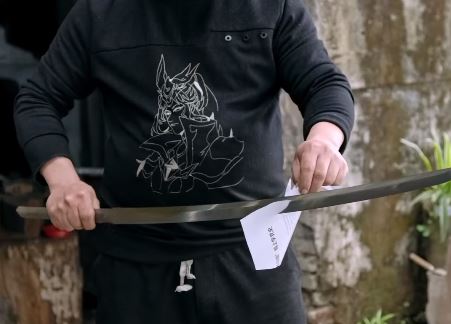
It is best to do a paper cut test every few passes. This way, you will see the actual sharpness of the blade and how much more sharpening it needs.
You can take any standard piece of paper and simply let the Katana fall down on it. Your blade is sharp if it can easily cut through the paper.
Wipe

After all of this is done, you will want to take a dry cloth and wipe it again as you did in the beginning. However, be careful because you will now hold a sharpened Katana in your hands.
Other Ways of Sharpening a Katana
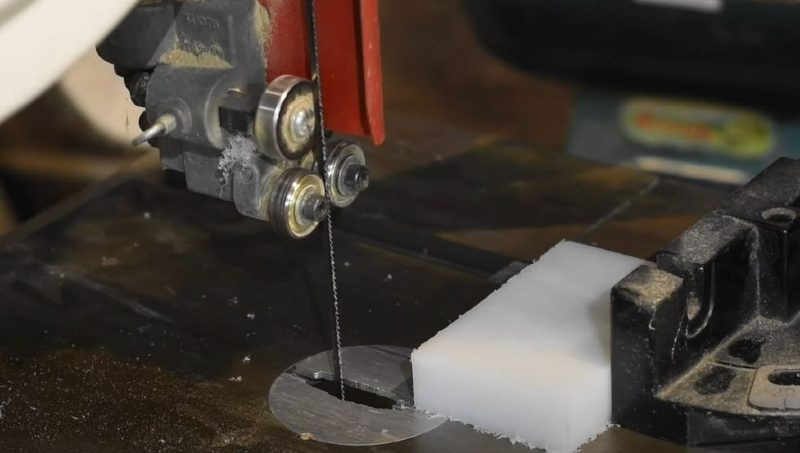
We have explained to you the most effective and traditional method of sharpening/polishing your Katana – the hand method. Let’s consider other ways how you can sharpen your Katana.
Sanding Belt
The sanding belt will move all the way up and down the machine as you move the sword’s blade. This tool is straightforward and will sharpen your Katana much faster than the hand method.
If you are a beginner, we advise against using this method on your first try.
Power Tools
Many machines will sharpen your sword perfectly if you just lay it down with the blade facing up.
Then turn the blade to the left and right to sharpen both sides. It is the easiest way to do it, and you don’t need any special skills. Therefore, some call it the “cheating” way to sharpen a sword.
However, using power tools can damage the blade of your Katana because of its fast friction. So we do not advise that you sharpen your Katana this way.
Expert Smith
If you are a beginner and aren’t sure that you will do a good enough job, you can always take it to your local swordsmith or blacksmith. However, you may need to pay a decent amount for sharpening a Katana, depending on where you live.
If you have an antique and decorated Katana, or possibly even a historical Katana, we advise you not to sharpen it yourself in case something goes wrong.
A typical Katana sharpening in the US will often cost around $120-$300, depending on how much sharpening it needs.
How Often & Why should you Sharpen your Katana
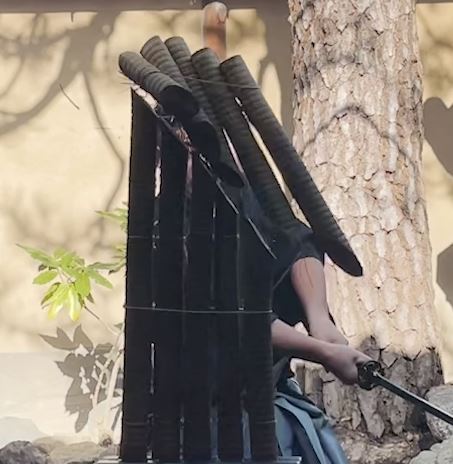
A Katana samurai sword should be sharpened 3-4 times per year.
The sharpening of a Katana is very beneficial as it will make your Katana long-lasting and effective for use. You may need to sharpen it more if you use it more regularly.
How Long Should a Sharpening of a Katana Take
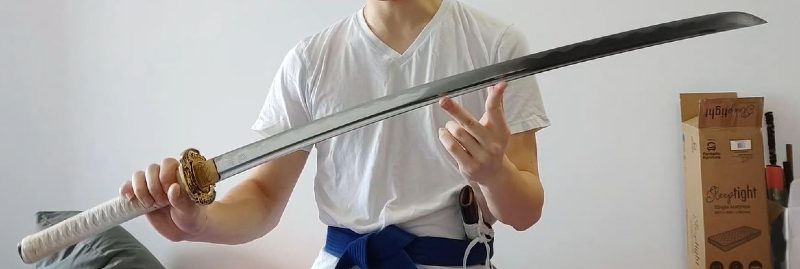
Sharpening a Katana will take as long as it needs.
You can sharpen your Katana for 2-3 hours at a time. Test the sharpness with a piece of paper each time you’re done. When it feels sharp enough, you can stop.
When working with a Katana, you will need to work with caution and patience. It is a delicate sword that can’t be rushed into sharpening.
The Japanese swordsmiths, called Togishi, can sometimes sharpen a Katana for up to 3 weeks! Depending on what type of quality Katana you have, you will occasionally need to give it days too.
When Should you Sharpen your Katana to be Razor Sharp
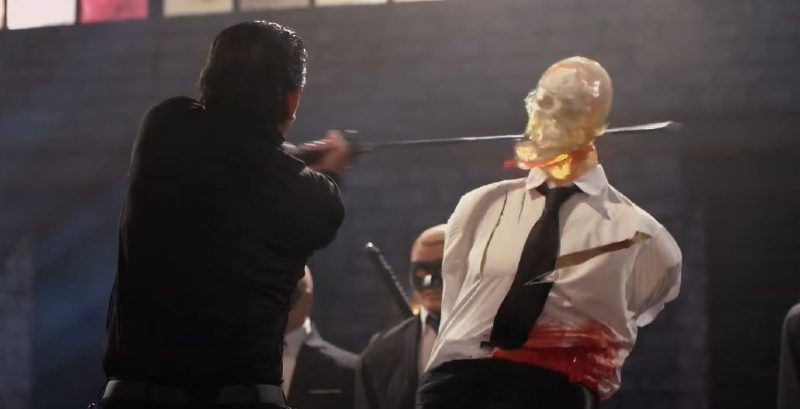
If you are a beginner, we strongly advise against sharpening your Katana to a razor sharp edge.
The main reason is, of course, safety, as you don’t want to injure yourself. However, you may also notice that the durability of a razor-sharp Katana will deteriorate faster, and you will need to sharpen it more often.
But if you are an expert and want to demonstrate your Katana slashing ability, it is more reasonable to do so. Still, treat the Katana with ease and caution. A small mistake with a razor-sharp Katana can be fatal.
History of Katana Sharpening
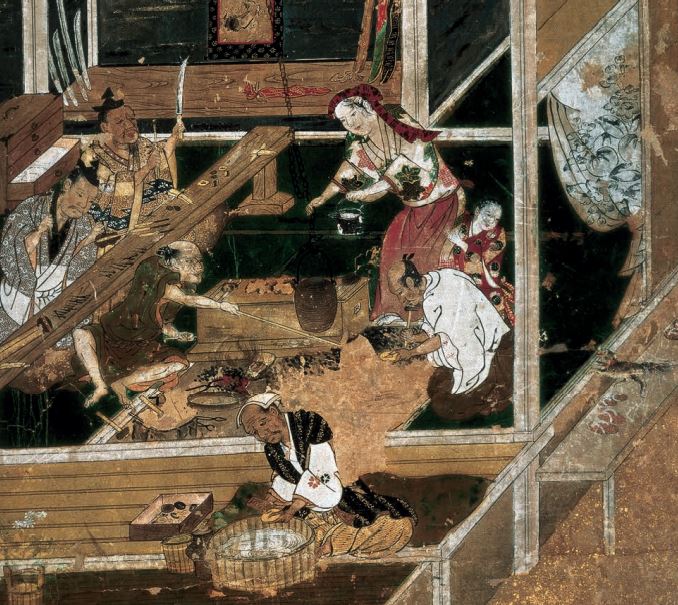
The sharpening or polishing of a Japanese Katana has been a formal art form since the Kamakura period (1185–1333). In Japan, there is no such thing as sharpening. It is simply called polishing.
The most important thing for the Japanese Samurai was having a reliable and sharp Katana. Sharpening was the single most important thing that every Samurai was supposed to know and do by themselves.
Today, only a few expert Japanese swordsmiths called Togishi are licensed and regulated by the NBTHK (Nihon Bijitsu Token Hozen Kyokai), which is the Society for the Preservation of the Japan Art Sword. It takes a full ten years of training to become a Togishi.
Conclusion
You may now begin honing your Katana sharpening abilities. Finally, all that’s left is to put in some time and practice. Do not try to speed through any of the procedures. The sharpening of this Japanese sword takes precision and time. Have fun with it, and may you succeed!





